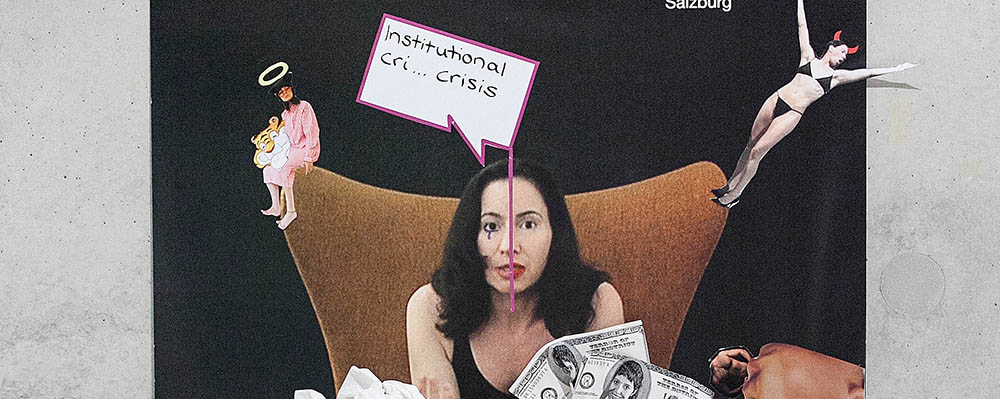Reflecting on Learning Processes
The Museumsakademie at the Museum der Moderne Salzburg and the work of Andrea Fraser
Developing experimental projects by students
Throughout the course we linked Andrea Fraser’s writings and the work shown in the exhibition to the students’ experiences and reflections. The students chose one of Andrea Fraser’s works for closer analysis, reflected on it within the context of a core theme and developed a project from their investigations. Our aim was to initiate a learning process and motivate students to pose their own questions and reflect on the boundaries of naturalized knowledge production and the possibilities of dismantling them.
Group “4 Posters” – Institutional critique: Stephanie Müllers, Stefanie Kern, Lisa Sommer, Elena Schuhmacher, Nina Druckenthaner, Marie-Therese Huemer
Zum Text: Nina Druckenthaner: Four Posters
This group reflected on the work 4 posters in the context of institutional critique. They focused on the university and a selection of posters and PR material from the university. Through interventions, they attempted to reveal the underlying assumptions made about the fields exemplified in the posters. For example, a poster for the career fair was contrasted with data on unemployment among academics. Also, the same poster showed a figure making a series of jumps, presumably on his or her career path. The group concealed the last jump by mounting a whirlwind above it, which would inevitably swallow the jumping figure.
Group “Untitled“ – Feminism and performance art: Anne-Fleur Werner, Anna Feiler, Daniela Fella, Nina Herzog, Maria Zehner
Zum Text: Daniela Fella: Untitled
This group discussed the video Untitled. Quite complicated issues arose in their discussion, which made their work difficult. The group began by reflecting on the artwork’s lack of a title or soundtrack. They asked museum visitors who had watched the video if they could give the artwork a name. Most people made associations with “sex.” By reflecting on this experiment, the group came to the conclusion that their method might have been counterproductive: Prompting visitors to answer spontaneously brought social stereotypes to the forefront and revealed a misogynist social order with regard to sexual encounters. This reveals once again that our class was more concerned with initiating processes of reflection than producing final results. The group later used the voices of the museum visitors as background noise for a controversial dialogue between an art critique explaining Fraser’s work and a visitor doubting its critical potential and artistic value.
Group “Therapy” – Art as social field: Isabella Stief, Maria Birnbaum, Astrid Rizner, Daniel Kranawetter, Lilia Ubert, Maja Beyreuther
Zum Text: Lilia Ubert: Projections
The third group chose the work therapy and reflected on the notion of art as a social field. They developed a performance on the theme of writing a master’s thesis. The group performed an inner dialogue of a student who feels overwhelmed by the task of writing a thesis and the multiple and contradictory demands that this entails. Each member of the group represented one of the internalized voices addressing the student, thus revealing the different norms, values, and interests of parents, teachers, peers, etc. After specifying the roles, a script was created, showing that some voices were more powerful than others, some positions more valuable than others.
Video „Masterarbeit“
Group “Recherche” – Art as social field: Anja Schönau, Susanne Zauner, Johanna Jung, Verena Leitner
Zum Text: Susanne Zauner: Museum für alle
Andrea Fraser elaborates in one of her articles that the museum has a public obligation. If the museum indeed wants to serve the public it needs to appeal to all classes of people and not only to those that legitimate taste (Fraser 1997). (*5) This appeal was the focus of the fourth project. “Imagine people who might go to the Museum der Moderne. How would you describe them?” The group posed this question to about 300 people in the city of Salzburg. They also asked them to write their answer together with their occupation on a sheet of white paper. The idea behind the project was to reveal the projections people in different social positions have about the so-called typical visitor to the MdM. Forty percent of those asked said that the typical visitor was “different,” “not like everybody else.” That is, the typical visitor was characterized as hip, creative, alternative, or special. At the same time, they also said that the museum wasn’t for them, because they were “just normal.” In this case normality seems to be in line with what Pierre Bourdieu calls popular taste. All in all, the students’ experiment shows once again that indeed, museums are primarily for those who legitimate taste; the educated, rich, distinguished, and less so for everyone else. Of course, it would be highly interesting to compare the results with the demographic statistics of the actual visitors to the MdM, but the museum did not provide them.
(*5) This appeal was the focus of the fourth project. “Imagine people who might go to the Museum der Moderne. How would you describe them?” The group posed this question to about 300 people in the city of Salzburg. They also asked them to write their answer together with their occupation on a sheet of white paper. The idea behind the project was to reveal the projections people in different social positions have about the so-called typical visitor to the MdM. Forty percent of those asked said that the typical visitor was “different,” “not like everybody else.” That is, the typical visitor was characterized as hip, creative, alternative, or special. At the same time, they also said that the museum wasn’t for them, because they were “just normal.” In this case normality seems to be in line with what Pierre Bourdieu calls popular taste. All in all, the students’ experiment shows once again that indeed, museums are primarily for those who legitimate taste; the educated, rich, distinguished, and less so for everyone else. Of course, it would be highly interesting to compare the results with the demographic statistics of the actual visitors to the MdM, but the museum did not provide them.
Elke Zobl, Elisabeth Klaus ( 2015): Reflecting on Learning Processes. The Museumsakademie at the Museum der Moderne Salzburg and the work of Andrea Fraser. In: p/art/icipate – Kultur aktiv gestalten # 06 , https://www.p-art-icipate.net/reflecting-on-learning-processes/




 Artikel drucken
Artikel drucken